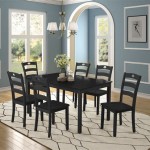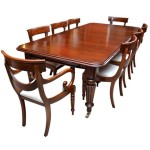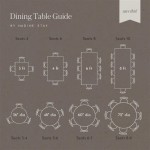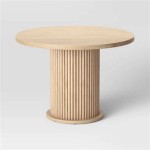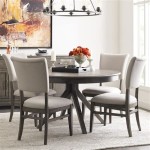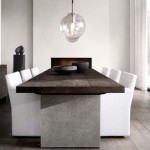Ashley Furniture Dining Table Leaf: A Comprehensive Guide
Ashley Furniture produces a wide variety of dining tables, catering to diverse tastes and spatial requirements. A key feature in many of their designs is the inclusion of a leaf, or leaves. The dining table leaf provides valuable flexibility, allowing the user to easily expand the table's surface area to accommodate additional guests or larger meals. Understanding the different types of leaves, how they function, and the characteristics that distinguish Ashley Furniture's offerings is essential for anyone considering purchasing a dining table with this feature.
This article will explore the function and types of dining table leaves commonly found in Ashley Furniture's product lines. It will also examine the mechanisms used to operate these leaves, the materials used in their construction, and considerations for choosing a dining table leaf that suits specific needs.
Understanding the Function of a Dining Table Leaf
The primary purpose of a dining table leaf is to increase the table's seating capacity. A dining table without a leaf is designed to accommodate a fixed number of people comfortably. When occasions arise that require more seating, such as family gatherings or dinner parties, the leaf can be inserted into the table, effectively lengthening its surface area. This eliminates the need for a larger table year-round, which may be impractical for everyday use and consume unnecessary space.
Beyond simply adding seating, a leaf can also enhance the overall dining experience. It allows for more elaborate meal presentations, providing ample space for serving dishes, condiments, and decorative elements. This is particularly beneficial during holidays or special occasions when larger and more complex menus are typically served. The extra space also allows for more comfortable movement and interaction between diners, preventing a cramped or restricted feeling.
Furthermore, a dining table leaf can provide increased functionality beyond dining purposes. It can be useful as a workspace for crafts, hobbies, or homework. The expanded surface offers a larger area to spread out materials and projects, making it easier to organize and focus. This versatility makes a dining table with a leaf a valuable asset in a multi-purpose living space.
Types of Dining Table Leaves Found in Ashley Furniture
Ashley Furniture employs various leaf designs in their dining tables, each offering unique advantages. The choice of leaf type often depends on the table's overall style, size, and intended use. Some of the most common types include:
Butterfly Leaf: This type of leaf is typically self-storing and hinged directly to the underside of the tabletop. When not in use, it folds in half and tucks away within the table's frame. To use it, the table is pulled apart at the center, and the butterfly leaf unfolds and locks into place. Butterfly leaves are convenient because they eliminate the need to store the leaf separately, preventing potential loss or damage. They are commonly found in smaller to mid-sized tables where storage space is a premium.
Drop-In Leaf: Drop-in leaves, also known as insert leaves, are separate pieces of wood or other material that are added to the table when needed. The table is typically pulled apart, creating a gap in the center, and the leaf is then dropped into place. Drop-in leaves offer greater flexibility in terms of size and number of leaves that can be used. Some Ashley Furniture tables can accommodate multiple drop-in leaves, significantly increasing the table's length. However, a drawback is that drop-in leaves need to be stored separately when not in use, requiring careful planning to prevent damage.
Self-Storing Leaf: This leaf type is similar to the butterfly leaf in that it is stored within the table itself. However, instead of folding, it typically slides or stores linearly under the tabletop. When the table is extended, the self-storing leaf is pulled out from its storage compartment and locked into place. This design provides a clean look and avoids the inconvenience of separate storage. The self-storing leaf design often requires a more complex mechanism than the butterfly leaf design.
Extension Leaf: This term is often used generically to refer to any type of leaf that extends the table. However, in some cases, it can refer to a specific leaf design where the table halves slide apart, and one or more leaves are added between them, often guided by rails or tracks. The extension leaf mechanism can be simpler than a self-storing design and allows for a gradual increase in table length if multiple leaves are used.
Mechanisms and Materials Used in Ashley Furniture Dining Table Leaves
The mechanism that operates the dining table leaf is crucial for ensuring smooth and reliable operation. Ashley Furniture uses a variety of mechanisms, ranging from simple slide mechanisms to more complex geared systems.
Slide Mechanisms: These mechanisms typically involve sliding the two halves of the table apart along a track or rail system. The leaf is then inserted into the gap created. Slide mechanisms are relatively simple and durable, making them a common choice for many dining tables. The quality of the hardware used in the slide mechanism is critical to its long-term performance. Rust-resistant materials and smooth gliding surfaces are important factors to consider.
Geared Mechanisms: More sophisticated dining tables might employ geared mechanisms to ensure that the table halves separate evenly and smoothly. These mechanisms often involve gears or levers that synchronize the movement of the table sections. This is particularly important for larger tables or tables with multiple leaves, as it ensures consistent alignment and prevents binding. Geared mechanisms are often more complex and potentially more prone to failure than simple slide mechanisms.
Locking Mechanisms: Regardless of the type of extension mechanism used, a secure locking mechanism is essential to ensure that the leaf stays firmly in place when in use. This prevents the table from collapsing or shifting unexpectedly. Locking mechanisms can range from simple latches to more elaborate cam-lock systems. The strength and reliability of the locking mechanism are crucial for safety and stability.
The materials used in the construction of the dining table leaf are equally important. Ashley Furniture typically uses wood, wood veneers, engineered wood products, and sometimes glass or other decorative materials. The choice of material depends on the table's overall design and price point.
Solid Wood: Solid wood leaves offer the highest level of durability and aesthetic appeal. They can be easily repaired or refinished if damaged and tend to maintain their value over time. However, solid wood leaves are typically more expensive and can be susceptible to warping or cracking if not properly cared for. Different types of wood, such as oak, maple, and acacia, offer varying degrees of hardness, grain patterns, and color variations.
Wood Veneers: Wood veneers consist of a thin layer of real wood adhered to a substrate, such as plywood or MDF (Medium-Density Fiberboard). Veneered leaves offer a similar appearance to solid wood at a lower cost. They are also less prone to warping than solid wood, as the underlying substrate provides stability. The quality of the veneer and the adhesive used are important factors to consider, as poor-quality veneers can peel or crack over time.
Engineered Wood Products: Engineered wood products, such as MDF and particleboard, are often used for the core of the leaf construction, even if a veneer is applied. These materials are less expensive than solid wood and offer good stability. However, they are generally less durable and more susceptible to water damage. The density and quality of the engineered wood product are important factors to consider.
The finish applied to the leaf is also important for both aesthetic and functional reasons. Finishes protect the wood from moisture, scratches, and stains, and can enhance its natural beauty. Ashley Furniture uses a variety of finishes, including lacquers, varnishes, and stains. The durability and ease of cleaning of the finish are important considerations.
Choosing the Right Dining Table Leaf for Your Needs
Selecting the appropriate dining table leaf requires careful consideration of several factors, including the size of your dining space, your typical seating needs, and your budget.
Space Considerations: Before purchasing a dining table with a leaf, it's essential to measure your dining space to ensure that the table, both in its retracted and extended configurations, will fit comfortably. Consider the amount of space needed for chairs and for people to move around the table. A table that is too large, even when the leaf is retracted, can make the room feel cramped and uncomfortable.
Seating Needs: Determine how many people you typically need to seat on a daily basis and how many you need to accommodate for larger gatherings. Choose a table with a leaf that will provide sufficient seating capacity for both scenarios. Consider that each person needs approximately 24 inches of linear space at the table for comfortable dining. Also, factor in the width of the chairs when calculating the overall space requirements.
Leaf Type and Mechanism: Evaluate the different types of leaves and mechanisms available and choose the one that best suits your needs and preferences. Consider the ease of use, storage requirements, and durability of each type. A butterfly leaf is a good option for smaller spaces where storage is limited, while a drop-in leaf provides greater flexibility for larger gatherings. A smooth and reliable extension mechanism is essential for easy operation.
Material and Finish: Choose a material and finish that complements your existing décor and that is durable and easy to maintain. Solid wood offers the highest level of durability and aesthetic appeal, but veneered or engineered wood leaves can be a more affordable option. Select a finish that is resistant to scratches, stains, and water damage. Consider the color and grain pattern of the wood to ensure that it blends well with your other furniture.
Budget: Dining tables with leaves can vary significantly in price, depending on the materials used, the complexity of the mechanism, and the brand. Set a budget before you start shopping and stick to it. Consider the long-term value and durability of the table when making your decision. A higher-quality table that will last for many years may be a better investment than a cheaper table that will need to be replaced sooner.
By carefully considering these factors, individuals can choose an Ashley Furniture dining table with a leaf that meets their specific needs and enhances their dining experience.

D371 32 Ashley Furniture Butterfly Leaf Counter Height Table

D212 32 Ashley Furniture Butterfly Leaf Counter Height Table

D527 32 Ashley Furniture Hamlyn Counter Height Leaf Table

Safavieh Clarity Drop Leaf Dining Table Ashley

D213 15 Ashley Furniture Cottage Retreat Round Drop Leaf Table

D193 15 Ashley Furniture Urbandale Drop Leaf Table

Ashley D199 15 Round Drm Drop Leaf Table

D19915 By Ashley Furniture Berringer Dining Drop Leaf Table Beiter S Mattress Appliance

D39815 By Ashley Furniture Gesthaven Dining Drop Leaf Table Berk S Mattress

Laura Ashley Oak Milton 4 6 Seater Drop Leaf Dining Table From The Next Uk


